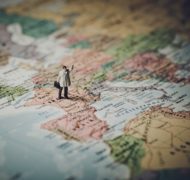The Great Big Cosmic Gospel
Blog / Produced by The High Calling
Below is my graphical representation of the Gospel. It is the four-chapter story of God’s working in history for the restoration of the cosmos that He created.
A few weeks ago, I presented this to a couple of guys in Colorado. They had just discovered that their father has terminal cancer, and I wanted to offer them the Good News so that they could make sense of this tragedy and perhaps move toward faith in Christ. It was fun to see these two men, one a grizzled outdoorsman, the other an aspiring artist, nod in affirmation and respond with insightful questions. It was a pleasure for my family to circle around that artist and pray for him and his family as they go through this difficult time, and that the two men would find comfort in the Lord and Savior Jesus Christ.
The Good News is more than the fact that Christ died for individual sinners. It is a cosmic story of God’s mission in the world, with the invitation to us to participate with him in this mission.
When I first present this to non-Christians, most resonate with the bigness of the story, and they begin to understand why Jesus came into the world and died on the cross. More often than not, it makes sense to them that God created a good world, that human rebellion has caused the creation to be broken, and that God, in Jesus Christ, rescues his creation. It also makes sense that God is inviting us to quit being a part of the problem and start becoming part of the solution.
When I first show this diagram to many Christians, they automatically place themselves, as individuals, into this timeline. “I was created, I sinned, I accepted Jesus and was redeemed/saved, and one day I will be in heaven.” But that is not the story. It is only part of the story. It takes a lot of de-programming to help them see this timeline not individualistically, but cosmically: that each of us are certainly in the storyline, but that the storyline is bigger than each one of us.
What God has been doing, through Christ, is the cosmic renewal of all things. When we begin to understand the full biblical story, we understand the gospel beyond how it is portrayed in evangelistic tracts that seek to simplify it to individual need and individual sin and individual salvation. We get the story of how God has been working throughout history to bring about his purposes.

CREATION
When God made all the aspects of the earth he saw that it was all good. And he puts humanity in charge of it.
“Then God said, ‘Let us make mankind in our image, in our likeness, so that they may rule over the fish in the sea and the birds in the sky, over the livestock and all the wild animals, and over all the creatures that move along the ground.’…God blessed them and said to them, ‘Be fruitful and increase in number; fill the earth and subdue it. Rule over the fish in the sea and the birds in the sky and over every living creature that moves on the ground.’” (Genesis 1:26, 28)
Humanity is created in the imago Dei, the image of God. This is who we are intrinsically. And the definition of being an image of God, while multi-faceted, has at its foundation the fact that humans are created to “rule” over the creation. We are placed in charge by the One who is in charge, to represent him.
Not only are the things of nature made by God, but there is order and meaning in life because God made it all. There is a proper way to work because God has made us to worship through our work. In fact, God actually made humanity to work. In Genesis 2:5, we read that the reason “no bush of the field was yet in the land and no small plant of the field had yet sprung up” was not only because God had not yet caused it to rain, but that “there was no man to work the ground.” The reason God placed Adam in the garden of Eden was so that he would “work it and keep it” (Genesis 2:15).
We have purpose in this world – intrinsically in each us as the image of God – to work.
FALL
Adam and Eve, however, failed in their role as the ones in charge of the created order. They did not trust that they could be all that they could be as image-bearers. They wanted more. They wanted to be God themselves (see Genesis 3:5). The Fall is the result of the human race not trusting God that he has our best interests in mind – and the best for us is to be fully human, robustly reflecting God into his creation. Instead of creating things for the common good, our pride and greed get in the way. Instead of caring for others and the created world, we manipulate them for our selfish interests. Instead of loving God and loving others, we love primarily ourselves.
The world is cursed, in need of redemption, in need of restoration. And God begins using human beings for this very purpose. Why? Because humans are His image-bearers; We are the ones who have been called to rule God’s world in righteousness and Shalom.
REDEMPTION - Accomplished
The gospel is not only about my personal salvation from my sins, but ultimately, it is the story of how Jesus is the King, the One that we must follow as he brings all things back into reconciliation with God (Colossians 1:19-20).
Scot McKnight, in his new book, The King Jesus Gospel: The Original Good News Revisited, writes, “What Adam was to do in the Garden—that is, to govern this world redemptively on God’s behalf—is the mission God gives to Israel. Like Adam, Israel failed, and so did its kings. God sent his Son to do what Adam and Israel and the kings did not (and evidently could not) do and to rescue everyone from their sins and systemic evil and Satan (the adversary). Hence, the Son is the one who rules as Messiah and Lord” (p. 35).
Contrary to the popular notion of the gospel in much of American evangelicalism, the story of the gospel does not start with me and my sins. It starts with God’s creation and intention for his image-bearers to rule over his creation. The story of the gospel does not skip over what God was doing in the Old Testament with Israel as if it has no bearing on the story, but is rooted in that story of Israel: their calling, their failure. The story of the gospel is about Jesus fulfilling that calling as King. Even with good intentions (trying to make the gospel more readily understood and accessible), when we disconnect the story of Jesus with the story of Israel, the story of humanity, and the story of cosmic restoration, we get a Jesus that is truncated, altered, and easily misunderstood.
REDEMPTION - Applied
When Christ died and was raised from the dead, the story of the Church shifted from ethnic Israel to the new Israel – the People of God who trust in Jesus. Christians are “God’s chosen people, a royal priesthood, a holy nation, God's special possession” charged with the duty of declaring the praises of God, who called us “out of darkness into his wonderful light” (1 Peter 2:9). God does an amazing work in us: He indwells us with his Holy Spirit through whom he progresses our transformation from sinners into the image of Jesus, empowering us to become fully human again. In other words, because of redemption, the image of God in us can become increasingly restored as we are made into the image of the perfect human, Jesus Christ.
We have purpose rooted in Creation: to care for and subdue the creation, to rule and to work for the common good. We also have purpose rooted in Redemption: to bring restoration to a broken world, to reconcile all things back to God, and to proclaim through our actions and our words that Jesus Christ, the King, is making the world right again.
CONSUMMATION
The story is consummated when Jesus returns and God finishes his work of making “all things new” (Revelation 21:5). Resurrected humans are then given authority to rule over the new earth, under the rule of Jesus the King. The imago Dei will be fully restored! The Creation will be as it should be!
Certainly it is good news that Jesus saves each one of us from our sins in the act of Justification. But let us not miss the grand, cosmic gospel. The really BIG good news is this: Jesus is the King, and He is redeeming and restoring God’s broken, fallen Creation. This is why we find that when Jesus proclaimed "the gospel" (or "good news") it was "the gospel of the kingdom" (Matthew 4:23).
What do you think are the implications of this cosmic gospel for the high calling of our daily work? How does vocation relate to creation, fall, redemption, and consummation? What are you doing in your vocation that reflects who you are as a person created in the image of God?
Images by Bob Robinson. Used with author's permission. Visit Reintegrate for a slide show of this presentation. Post by Bob Robinson, Faith Editor for The High Calling and the Executive Director of The Center to Reintegrate Faith, Life, and Vocations. Follow Reintegrate's tweets at @re_integrate and Bob's personal twitter at @Bob_Robinson_re





